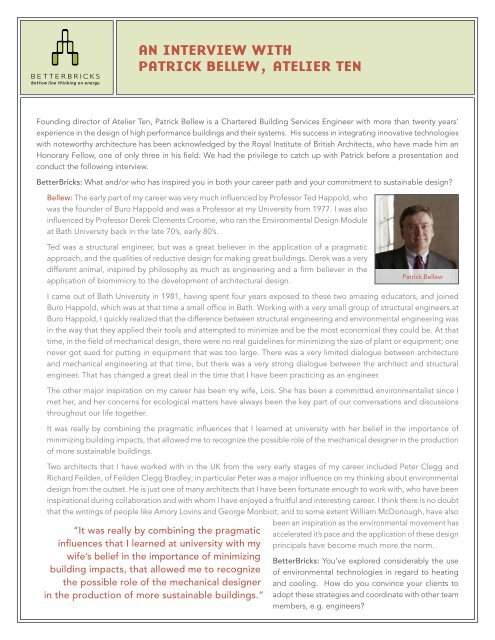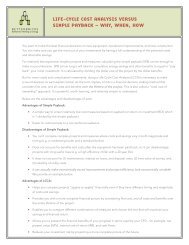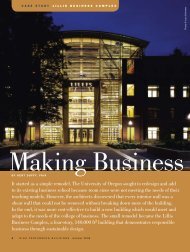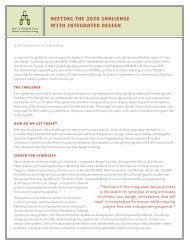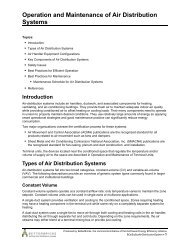An IntervIew wIth PAtrIck Bellew, AtelIer ten - BetterBricks
An IntervIew wIth PAtrIck Bellew, AtelIer ten - BetterBricks
An IntervIew wIth PAtrIck Bellew, AtelIer ten - BetterBricks
Create successful ePaper yourself
Turn your PDF publications into a flip-book with our unique Google optimized e-Paper software.
<strong>An</strong> <strong>IntervIew</strong> <strong>wIth</strong><br />
<strong>PAtrIck</strong> <strong>Bellew</strong>, <strong>AtelIer</strong> <strong>ten</strong><br />
Founding director of Atelier Ten, Patrick <strong>Bellew</strong> is a Chartered Building Services Engineer with more than twenty years’<br />
experience in the design of high performance buildings and their systems. His success in integrating innovative technologies<br />
with noteworthy architecture has been acknowledged by the Royal Institute of British Architects, who have made him an<br />
Honorary Fellow, one of only three in his field. We had the privilege to catch up with Patrick before a presentation and<br />
conduct the following interview.<br />
<strong>BetterBricks</strong>: What and/or who has inspired you in both your career path and your commitment to sustainable design?<br />
<strong>Bellew</strong>: The early part of my career was very much influenced by Professor Ted Happold, who<br />
was the founder of Buro Happold and was a Professor at my University from 1977. I was also<br />
influenced by Professor Derek Clements Croome, who ran the Environmental Design Module<br />
at Bath University back in the late 70’s, early 80’s.<br />
Ted was a structural engineer, but was a great believer in the application of a pragmatic<br />
approach, and the qualities of reductive design for making great buildings. Derek was a very<br />
different animal, inspired by philosophy as much as engineering and a firm believer in the<br />
application of biomimicry to the development of architectural design.<br />
I came out of Bath University in 1981, having spent four years exposed to these two amazing educators, and joined<br />
Buro Happold, which was at that time a small office in Bath. Working with a very small group of structural engineers at<br />
Buro Happold, I quickly realized that the difference between structural engineering and environmental engineering was<br />
in the way that they applied their tools and attempted to minimize and be the most economical they could be. At that<br />
time, in the field of mechanical design, there were no real guidelines for minimizing the size of plant or equipment; one<br />
never got sued for putting in equipment that was too large. There was a very limited dialogue between architecture<br />
and mechanical engineering at that time, but there was a very strong dialogue between the architect and structural<br />
engineer. That has changed a great deal in the time that I have been practicing as an engineer.<br />
The other major inspiration on my career has been my wife, Lois. She has been a committed environmentalist since I<br />
met her, and her concerns for ecological matters have always been the key part of our conversations and discussions<br />
throughout our life together.<br />
It was really by combining the pragmatic influences that I learned at university with her belief in the importance of<br />
minimizing building impacts, that allowed me to recognize the possible role of the mechanical designer in the production<br />
of more sustainable buildings.<br />
Two architects that I have worked with in the UK from the very early stages of my career included Peter Clegg and<br />
Richard Feilden, of Feilden Clegg Bradley; in particular Peter was a major influence on my thinking about environmental<br />
design from the outset. He is just one of many architects that I have been fortunate enough to work with, who have been<br />
inspirational during collaboration and with whom I have enjoyed a fruitful and interesting career. I think there is no doubt<br />
that the writings of people like Amory Lovins and George Monbiot, and to some ex<strong>ten</strong>t William McDonough, have also<br />
“It was really by combining the pragmatic<br />
influences that I learned at university with my<br />
wife’s belief in the importance of minimizing<br />
building impacts, that allowed me to recognize<br />
the possible role of the mechanical designer<br />
in the production of more sustainable buildings.”<br />
Patrick <strong>Bellew</strong><br />
been an inspiration as the environmental movement has<br />
accelerated it’s pace and the application of these design<br />
principals have become much more the norm.<br />
<strong>BetterBricks</strong>: You’ve explored considerably the use<br />
of environmental technologies in regard to heating<br />
and cooling. How do you convince your clients to<br />
adopt these strategies and coordinate with other team<br />
members, e.g. engineers?
<strong>Bellew</strong>: We have explored and developed high performance building technologies over many years with greater and<br />
lesser degrees of success with our clients. In every project, we attempt to bring in a degree of environmental thinking;<br />
usually phrasing it in terms of ‘no-brainers’ that one ought to do as a matter<br />
of course on the building. The next level are things that are slightly more of a<br />
stretch to reach, and then on to the more complex things that require a major<br />
shift in thinking about how buildings perform. We have been fortunate, however,<br />
to work with many clients for whom a push towards more sustainable design<br />
has been at the core of the selection process of their design team. In the early<br />
days, this type of client <strong>ten</strong>ded to be either owner/occupiers of buildings, such<br />
as universities and schools, or they would come from the government sector or<br />
The Blue Bird Restaurant and Store in London<br />
cultural buildings such as art museums, schools again or public buildings of any<br />
kind. These were people who both owned and operated the buildings and, as<br />
it’s now phrased, the triple bottom line applied to very well. This means that they were paying the fuel bills, and so the<br />
benefits of investment in energy reduction were clearly demonstrable throughout the life of the building. It has been<br />
far more difficult to persuade the developers of commercial buildings, who are not paying their own fuel bills, to come<br />
to the party and build high performance, sustainable buildings.<br />
This has changed somewhat in recent years, particularly the last two years in the UK, where the corporate<br />
social responsibility demands of the po<strong>ten</strong>tial building <strong>ten</strong>ants have moved our commercial sector much more<br />
towards the development of high performance buildings. I would say this has certainly been helped by the<br />
emergence of benchmarking rating systems. In the UK this is BREEAM, and in the US this is LEED. The impact of<br />
these benchmarking systems has been really significant in encouraging developers to achieve higher standards<br />
for their buildings, and recognize that they have a better chance of leasing a building that’s deemed to be high<br />
quality, than leasing a building that’s either not certified or of a lower quality. In a way this is exactly what the<br />
benchmarking systems set out to achieve in the first place. They are frequently derided by the nay-sayers as being a<br />
painful process, involving too much paper pushing, and many other negatives. However, I think they add extraordinary<br />
value in providing a level playing field for comparison of designs and design qualities.<br />
Our experiences in the US in recent years have very much paralleled this situation in the UK. Our earlier projects were<br />
almost exclusively with universities and one or two enligh<strong>ten</strong>ed developers, such as Liberty Property Trust out of<br />
Philadelphia. The universities were beginning to recognize the benefits of reducing their energy consumption and their<br />
infrastructure costs when developing new buildings, if they<br />
built them to a higher standard. At the same time, or soon<br />
after, the property development sector recognized that there<br />
were some pretty big changes on the horizon and started to<br />
respond. I wouldn’t say that they are all the way there yet,<br />
but certainly a good start is being made in certain parts of<br />
the country.<br />
To respond to the second part of the question, about how<br />
to coordinate with other team members; the truth is that<br />
sometimes it’s very straight forward, and sometimes it’s<br />
not. Despite the fact that it is widely recognized that the<br />
architecture of the building is a key component of the way that<br />
buildings perform, and despite the fact that all the architects<br />
that we work with seek to incorporate environmental design<br />
Despite it is widely recognized that<br />
the architecture of the building is a key<br />
component to a buildings performance,<br />
and despite that all the architects that<br />
we work with seek to incorporate<br />
environmental design measures into<br />
their buildings, there still remains a<br />
reluctance on the part of many architects<br />
to compromise architectural or aesthetic<br />
considerations for a technical one, no<br />
matter how carefully they are explained!<br />
measures into their buildings, there still remains a reluctance on the part of many architects to compromise architectural<br />
or aesthetic considerations for a technical one, no matter how carefully they are explained!<br />
As the calculation tools have become more user friendly and particularly more graphical in the way that they represent<br />
energy flows within buildings, we have found it increasingly viable to speak with the architects at a graphical level, get<br />
Patrick <strong>Bellew</strong><br />
2
them to understand the consequences of their decisions, and start to move towards making better buildings. For the<br />
most part however, the collaborative relationship within design teams, whether it be architects or structural engineers,<br />
has been exciting and for the most part fruitful.<br />
“In the earlier part of<br />
my career, we used<br />
to do what we called<br />
“stealth” engineering...<br />
The minute that you put<br />
it up as an additional<br />
item in the “green<br />
column” of the analysis,<br />
it is then a hostage to<br />
fortune and to budget<br />
cuts, whereas we would<br />
rather see it as being<br />
an intrinsic part of a<br />
good building.”<br />
Nonetheless, a realistic look back at many of our projects would suggest that<br />
most clients prepare a little bit in their ambitions, but moving them to more<br />
innovative environmental ideas still remains extremely difficult. I do think that<br />
sometimes we over analyze the things that we are doing.<br />
In the earlier part of my career, we used to do what we called “stealth” engineering<br />
where we would simply install something, such as heat recovery, as standard on all<br />
the ventilation systems in the building, having satisfied ourselves that the energy<br />
efficiency gained was worth having. We wouldn’t necessarily do the detailed<br />
life cycle cost analysis to show that the client would realize a benefit over the<br />
long term, because we knew it would be so. The minute that you put it up as<br />
an additional item in the “green column” of the analysis, it is then a hostage to<br />
fortune and to budget cuts, whereas we would rather see it as being an intrinsic<br />
part of a good building. So these days, we do a combination of things that we<br />
just do as standard, and we then look for areas where we can “push the boat<br />
out” to make for buildings that move the debate about green design forward.<br />
<strong>BetterBricks</strong>: Are you familiar with the AIA’s 2030 Challenge? How would you characterize the best approach or strategies<br />
to get to net-zero carbon buildings?<br />
<strong>Bellew</strong>: I have some knowledge of the AIA’s 2030 Challenge documentation, and I think that it contains a very strong<br />
message. In the UK, our government is looking to mandate a more ambitious timeline to carbon neutral buildings, aiming<br />
for the domestic sector to be carbon neutral by 2016 and the commercial sector to be carbon neutral by 2019.<br />
There is some debate about the meaning of carbon neutral, and a particular debate is developing about the fact that<br />
the carbon neutrality of the project is in<strong>ten</strong>ded to be established without the ability to import energy from green sources<br />
offsite, or by using certified renewable energy credits. As you can imagine, this makes life rather challenging! There<br />
is also some debate about the definition of zero carbon and the tax breaks that are being allocated to zero carbon<br />
buildings; one supposes the treasury tries to make it difficult to achieve them in order to minimize the number of tax<br />
concessions they have to give!<br />
I wouldn’t take issue with any of the points raised in the 2030 Challenge headlines, except to highlight that one thing<br />
we are very interested in looking into is how we can make the construction of new buildings somehow link to the energy<br />
reduction in the existing building stock. To me it always seems crazy to spend a million dollars on a photovoltaic array<br />
to take a building from a 60% carbon reduction to a 64% carbon reduction, when<br />
the same amount of carbon could be saved by spending $250,000 on an adjoining<br />
building or nearby housing estate. How do we put in place mechanisms to allow<br />
the money to flow from one sector to another, and avoid wasting the green dollar<br />
on uneconomic renewable energy systems, when there are much softer targets<br />
nearby? I know this is a really difficult problem to solve, but it seems to me to be<br />
one that our legislature needs to get its head around in order to allow it to become<br />
part of the planning system.<br />
In the UK, the town of Brighton has recently introduced a system that allows<br />
developers to realize the best building performance possible by incorporating<br />
economically feasible renewable sources into the design. <strong>An</strong>y short fall from the<br />
required 10-20% renewable energy target, in effect any residual carbon emissions<br />
can be paid off via a one-off development charge. This then goes into a community<br />
Monsoon PLC in London<br />
Patrick <strong>Bellew</strong><br />
3
fund and is used to provide zero cost installation for existing residential home owners. Installing solar panels, insulation,<br />
double-glazing and the like to dramatically improve the energy performance. Personally, I think that this is one of the<br />
biggest tools in the box beyond design for very high performance buildings.<br />
It would be a very long interview if I were to try and deal with how you go about getting to zero carbon buildings!<br />
I think the process of demand minimization and then the installation of very high performance building systems is<br />
clearly the key, but how we deal with delivering electrical renewable energy in particular on these projects is still a<br />
very challenging question.<br />
<strong>BetterBricks</strong>: What have you learned from your experience incorporating biomimicry principles into buildings? <strong>An</strong>y advice<br />
for architects? Or engineers?<br />
<strong>Bellew</strong>: In my lecture I cover my favorite bit of biomimicry, which is the nest of the termite. I talk a little bit about<br />
the magnetic termite and the barossa termite. These creatures have an amazing way of constructing their nests, and<br />
in particular they use a thermal storage system contained in the ground and the earth tube that brings air into the<br />
nest. They also use evaporation of water to provide cooling in these<br />
same heat stores to produce an air conditioning effect without actually<br />
running any chillers. We have used these principals many times on our<br />
buildings to integrate subterranean thermal storage into air conditioning<br />
pre-heat and pre-cooling systems to minimize the demands on the air<br />
handling plant in the building, providing comfortable conditions with<br />
very low energy consumption. So I believe very strongly in the principal<br />
of biomimicry as a way of mirroring design techniques. However, I think<br />
there is a limit to the ex<strong>ten</strong>t to which it can be applied. Nonetheless, I<br />
have found it extremely useful in getting across to clients the benefits of certain types of systems, and establishing a<br />
clear understanding that it’s physical principles that we are working with and not smoke and mirrors!<br />
<strong>BetterBricks</strong>: What do you see as future energy trends in the sustainable building market? What about future business<br />
opportunities?<br />
<strong>Bellew</strong>: I think there is no doubt that the renewable energy market will follow a broad range of applications in the years<br />
to come. The question is, which one will give us the biggest benefit? I have always been a big fan of earth energy<br />
systems, and how we have applied a wide range of earth energy techniques to buildings in recent years to minimize<br />
demands and reduce or eliminate the need for air conditioning.<br />
To me this seems to be one very logical place for us to start from. I would have to say that I am not a great believer in<br />
the application of building based wind technologies. Recent trials underway in the UK suggest that the performance of<br />
building integrated turbines are rarely as good as one would hope, largely because<br />
of the very disturbed air surrounding the buildings. The move towards biomass<br />
based heating and combined heat and power systems in the UK is gaining some<br />
momentum, and I think in a balanced, green energy world, should such a thing exist,<br />
we will be looking at a proportion of our building energy demands being met from<br />
biomass equipment. The argument about the macro economic and social economic<br />
implications of this continues to rage, and as an engineer I am not sure I have all the<br />
answers regarding what the right solution is, but I do think in the right application,<br />
biofuels have a role to play.<br />
Ineos in Southampton, Hampshire<br />
“I think there is no doubt that<br />
the renewable energy market<br />
will follow a broad range of<br />
applications in the years to come.<br />
The question is, which one will<br />
give us the biggest benefit?”<br />
We have installed many solar hot-water heating systems as an integral part of both<br />
residential and office schemes, and it seems to me that this is one of the simpler<br />
technologies that we should be using a lot more. PV is altogether a more difficult<br />
Patrick <strong>Bellew</strong><br />
4
question, but there are an increasing number of examples of economies that have benefited greatly from setting<br />
tariffs to generate a strong PV industry at the same time as offsetting a small proportion of building energy loads. I<br />
would certainly say that they have a role to play in the future of high performance buildings. When it comes down<br />
to it, however, the real gains that are to be made have to be in the way that architecture and engineering work<br />
together to produce buildings that are just altogether leaner and greener, and have to rely a lot less on these new<br />
technologies to meet their energy demands.<br />
“When it comes down to it, however,<br />
the real gains that are to be<br />
made have to be in the way that<br />
architecture and engineering work<br />
together to produce buildings<br />
that are just altogether leaner and<br />
greener, and have to rely a lot<br />
less on these new technologies to<br />
meet their energy demands.”<br />
One area of design that really doesn’t get enough at<strong>ten</strong>tion in this<br />
regard, I believe, is the importance of daylighting. The more one works<br />
on projects, both in the commercial and retail sectors, the more one<br />
realizes the amount of energy we actually waste on lighting buildings<br />
when there is perfectly good daylight outside. Even in buildings that<br />
have huge amounts of glass, and on days that are not very sunny, one<br />
still sees massive amounts of lighting on. This is because lighting control<br />
systems are not adequately developed or invested in to produce the<br />
energy savings that go with good daylighting. It seems to me that there<br />
are many areas here that we can get our house in order before we move to<br />
a great and anxious debate over how big the solar panels should be.<br />
On the positive side, there is no doubt that the future business opportunities in this area are considerable. As more and<br />
more corporations and large businesses take up their corporate social responsibility statements and start to try to make<br />
them real, they rapidly realize that it is their real estate they have to look to, to quickly promote the improvements that<br />
they are claiming. They will also be looking to occupy new buildings that have better environmental credentials than the<br />
buildings that they currently occupy. It seems to me that this is the key lever in the development of high performance<br />
buildings in the future. The future trends in this building market are all about clients demanding more, and design teams<br />
working in a more integrated way to deliver the solutions that they need.<br />
A particular interest to us in the US market has been the emergence of the sustainable design consultant in the design<br />
team. This is the space that Atelier Ten occupies in the US, although in the UK we also work as MEP (Mechanical,<br />
Electrical and Plumbing) engineers. It seems to me that the US market is very open to the idea of a designer working<br />
with the architect, helping to develop the best possible building envelope and response to orientation, massing and<br />
form, but at the same time also working with the MEP engineers to integrate<br />
high performance systems into these building envelopes. The influence<br />
will spread right down the supply chain; I am talking now about designers,<br />
but it also ex<strong>ten</strong>ds right through from material suppliers, contractors, water<br />
engineers, water treatment engineers. Everyone who is involved in some<br />
inflow or outflow from our buildings will have a part to play in building a<br />
Plaza at PPL Center in Allentown, PA<br />
more sustainable future for the construction industry.<br />
Patrick <strong>Bellew</strong><br />
5


